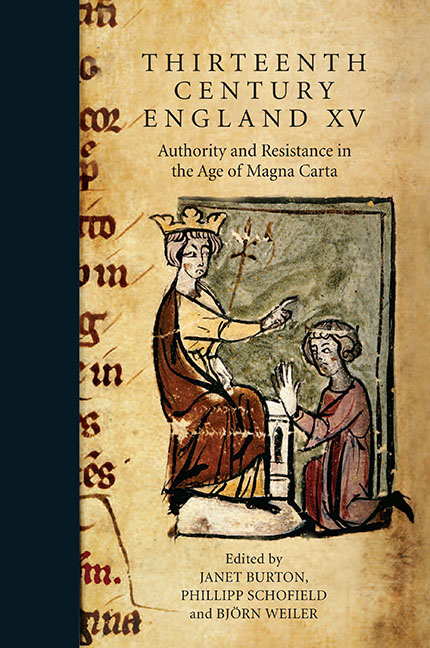 Thirteenth Century England XV
Thirteenth Century England XV Published online by Cambridge University Press: 11 June 2021
The opening pages of Matthew Paris's Historia Anglorum (BL, Royal MS 14 C. vii) provide the reader with an introduction to the themes of kingship and authority found throughout this manuscript and his work as a whole. The work opens with a sequence of images that shows the kings of England, the itineraries from London to Apulia, and the maps of the Holy Land and England within a broader European context, while at the same time marking indelibly the prominence given to the role of the monarch within the chronicle. The images play an important role not just in the framing of the history with these visual statements of royal authority but also, through the use of signa, highlighting the themes of authority and dissent found within the manuscript.
The thirteenth-century monk Matthew Paris (c. 1200–1259) was a prolific author and illuminator. He produced several chronicles of different sizes that were noted not only for the quality of his writing but also for the significant role he gave to images. These histories include the Chronica Majora (Cambridge, Corpus Christi College, MS 26, 16; BL, Royal MS 14 C. vii, fols 157r–218v), the Historia Anglorum (BL, Royal MS 14 C. vii, fols 10r–156v), the Abbreviatio Chronicorum (BL, Cotton MS Claudius D.vi, fols 2–94), while another Cotton manuscript, MS Nero D.i, also includes the Chronica Majora's Liber Additamentorum, the Gesta Abbatum, and the Vitae duorum Offarum. In addition Matthew's writings provided the basis for the Flores Historiarum (Manchester, Chetham Library MS 6712), produced for Westminster Abbey, and containing his distinctive hand on folios 170v–200v. While much of the discussion on the art has focused on the encyclopaedic Chronica Majora or the maps, the Historia Anglorum also provides opportunities to explore Matthew Paris's work further.
Paris began compiling this book in 1250, as he himself records. Unlike the Chronica Majora which began with the Creation, the Historia Anglorum covers a shorter timeframe, from the Norman Conquest until 1253. It does share in its use of marginal imagery and accompanying prefatory material features that appear in Paris's other chronicles, although no two manuscripts follow the same formula. The manuscript of the Historia Anglorum makes up the first 156 of the 232 folios. The final section of the Chronica Majora is also bound into this volume.
To save this book to your Kindle, first ensure [email protected] is added to your Approved Personal Document E-mail List under your Personal Document Settings on the Manage Your Content and Devices page of your Amazon account. Then enter the ‘name’ part of your Kindle email address below. Find out more about saving to your Kindle.
Note you can select to save to either the @free.kindle.com or @kindle.com variations. ‘@free.kindle.com’ emails are free but can only be saved to your device when it is connected to wi-fi. ‘@kindle.com’ emails can be delivered even when you are not connected to wi-fi, but note that service fees apply.
Find out more about the Kindle Personal Document Service.
To save content items to your account, please confirm that you agree to abide by our usage policies. If this is the first time you use this feature, you will be asked to authorise Cambridge Core to connect with your account. Find out more about saving content to Dropbox.
To save content items to your account, please confirm that you agree to abide by our usage policies. If this is the first time you use this feature, you will be asked to authorise Cambridge Core to connect with your account. Find out more about saving content to Google Drive.